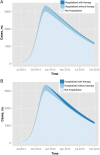Evaluating large-scale blood transfusion therapy for the current Ebola epidemic in Liberia
- PMID: 25635118
- PMCID: PMC4447839
- DOI: 10.1093/infdis/jiv042
Evaluating large-scale blood transfusion therapy for the current Ebola epidemic in Liberia
Abstract
Background: To combat the 2014-2015 Ebola virus disease (EVD) epidemic in West Africa, the World Health Organization urged the rapid evaluation of convalescent whole blood (CWB) and plasma (CP) transfusion therapy. However, the feasibility and likely impacts of broad implementation of transfusions are yet unknown.
Methods: We extended an Ebola virus transmission model published by the Centers for Disease Control and Prevention to include hospital-based convalescent donations and transfusions. Using recent epidemiological estimates for EVD in Liberia and assuming that convalescent transfusions reduce the case-fatality rate to 12.5% (range, 7.5%-17.5%), we projected the impacts of a countrywide ramp-up of transfusion therapy.
Results: Under the 10% case-hospitalization rate estimated for Liberia in September 2014, large-scale CP therapy is expected to save 3586 lives by October 2015 (3.1% mortality reduction; 95% confidence interval [CI], .52%-4.5%). Under a higher 30% hospitalization rate, CP transfusions are expected to save 151 lives (0.9% of the total; 95% CI, .21%-11%).
Conclusions: Transfusion therapy for EVD is a low-cost measure that can potentially save many lives in West Africa but will not measurably influence the prevalence. Under all scenarios considered, CP transfusions are predicted to achieve greater reductions in mortality than CWB.
Keywords: Ebola virus disease; convalescent blood; dynamic model; polyclonal antibody therapy; transfusion.
© The Author 2015. Published by Oxford University Press on behalf of the Infectious Diseases Society of America. All rights reserved. For Permissions, please e-mail: journals.permissions@oup.com.
Figures


Comment in
-
Large-scale convalescent blood and plasma transfusion therapy for Ebola virus disease.J Infect Dis. 2015 Apr 15;211(8):1208-10. doi: 10.1093/infdis/jiv043. Epub 2015 Jan 29. J Infect Dis. 2015. PMID: 25635120 No abstract available.
Similar articles
-
The Use of Ebola Convalescent Plasma to Treat Ebola Virus Disease in Resource-Constrained Settings: A Perspective From the Field.Clin Infect Dis. 2016 Jan 1;62(1):69-74. doi: 10.1093/cid/civ680. Epub 2015 Aug 10. Clin Infect Dis. 2016. PMID: 26261205 Free PMC article. Clinical Trial.
-
Large-scale convalescent blood and plasma transfusion therapy for Ebola virus disease.J Infect Dis. 2015 Apr 15;211(8):1208-10. doi: 10.1093/infdis/jiv043. Epub 2015 Jan 29. J Infect Dis. 2015. PMID: 25635120 No abstract available.
-
Evaluation of convalescent whole blood for treating Ebola Virus Disease in Freetown, Sierra Leone.J Infect. 2017 Mar;74(3):302-309. doi: 10.1016/j.jinf.2016.11.009. Epub 2016 Nov 17. J Infect. 2017. PMID: 27867062 Free PMC article.
-
Ebola virus: current and future perspectives.Infect Disord Drug Targets. 2015;15(1):20-31. doi: 10.2174/1871526515666150320162259. Infect Disord Drug Targets. 2015. PMID: 25910510 Review.
-
Treatment of ebola virus disease.Pharmacotherapy. 2015 Jan;35(1):43-53. doi: 10.1002/phar.1545. Pharmacotherapy. 2015. PMID: 25630412 Review.
Cited by
-
Anti-Ebola therapies based on monoclonal antibodies: current state and challenges ahead.Crit Rev Biotechnol. 2017 Feb;37(1):53-68. doi: 10.3109/07388551.2015.1114465. Epub 2015 Nov 26. Crit Rev Biotechnol. 2017. PMID: 26611830 Free PMC article. Review.
-
Treatment-donation-stockpile dynamics in ebola convalescent blood transfusion therapy.J Theor Biol. 2016 Mar 7;392:53-61. doi: 10.1016/j.jtbi.2015.11.031. Epub 2015 Dec 23. J Theor Biol. 2016. PMID: 26721704 Free PMC article.
-
A pregnant woman with COVID-19 gives birth to premature triplets: A case report and literature review.Med Int (Lond). 2022 Feb 14;2(1):6. doi: 10.3892/mi.2022.31. eCollection 2022 Jan-Feb. Med Int (Lond). 2022. PMID: 36700154 Free PMC article.
-
Plasma therapy against infectious pathogens, as of yesterday, today and tomorrow.Transfus Clin Biol. 2016 Feb;23(1):39-44. doi: 10.1016/j.tracli.2015.12.003. Epub 2016 Jan 6. Transfus Clin Biol. 2016. PMID: 26775794 Free PMC article. Review.
-
Engineering Antibodies for the Treatment of Infectious Diseases.Adv Exp Med Biol. 2017;1053:207-220. doi: 10.1007/978-3-319-72077-7_10. Adv Exp Med Biol. 2017. PMID: 29549641 Free PMC article. Review.
References
-
- Meltzer MI, Atkins CY, Santibanez S, et al. Estimating the future number of cases in the Ebola epidemic—Liberia and Sierra Leone, 2014–2015. MMWR Surveill Summ 2014; 63(suppl 3):1–14. - PubMed
-
- Ledgerwood JE, DeZure AD, Stanley DA, et al. Chimpanzee adenovirus vector Ebola vaccine—preliminary report. N Engl J Med 2014; doi:10.1056/NEJMoa1410863. - DOI - PubMed
Publication types
MeSH terms
Grants and funding
LinkOut - more resources
Full Text Sources
Other Literature Sources
Medical
Miscellaneous

